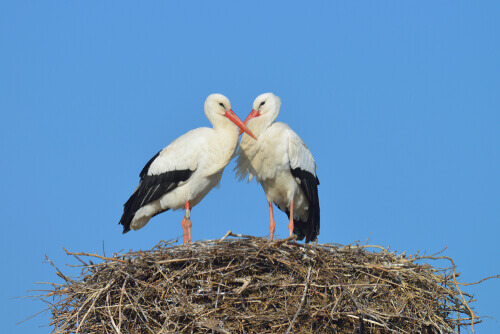The Stork, a Very Maternal Bird

We often talk about the stork when explaining birth to young children. However, we don’t know much about this species that lives in Africa, Europe, and Asia. In this article, we’ll tell you all about it.
The characteristics of the stork
Although it’s called the white stork, this bird also has black wings. In addition, its long orange beak and legs stand out, as well as its black eyes.
It’s a big bird with a wingspan of 10 feet. Thanks to its wide wings, it can glide. It flaps slowly, and it stretches its neck forward and its legs backward when it flies. To sleep, it “hides” its head between its feathers and, when it walks, it does so slowly, looking down.
As for its diet, as it’s a carnivore, it eats many different small animals: fish, reptiles, insects, birds, or mammals. To feed, it takes food directly with its beak from the ground, especially in low vegetation areas or in shallow bodies of water.
The stork is monogamous. Once it mates, it stays with the same partner for life. Both partners work together to build a large nest, which they’ll be able to use for several seasons. The females lay about four eggs. The parents take turns incubating them until they hatch after a month. After the chicks hatch, their partners feed them for two months.
Stork distribution and migration
A quarter of the world’s stork population inhabits Poland. However, this migratory bird travels long distances each year, depending on the season. To be able to survive the winter and not have to endure the typical cold of Eastern Europe, it travels to India, the Arabian peninsula, and sub-Saharan Africa.
A very curious fact about this bird is that, to reach African lands, it “avoids” crossing the Mediterranean Sea. On the contrary, it deviates towards the Strait of Gibraltar or the Mediterranean Levant. This allows it to take better advantage of the air currents that form over the water.
When spring begins, the stork returns to Europe after an approximate 49-day journey. The outward journey is about 26 days, due to the direction and speed of the winds, the amount of food it finds, the energy it has, etc.
The stork in culture
This bird is in many ancient legends and traditions due to its behavior, its flight, the fact that it nests near human settlements, its size, and its feeding. In Ancient Egypt, it was associated with the human soul; Jews consider it a merciful being.
The Greeks and Romans associated the stork with fatherhood. In fact, one of their myths states that stork specimens don’t die but that they instead fly to distant islands and become people. Likewise, this bird is the protagonist of several fables, such as the Fox and the Stork. The Muslims venerate it during their pilgrimage to Mecca.
But, of course, most people associate the stork with the bird that delivers babies to their parents. This legend dates back to the 19th century, thanks to a story by Hans Christian Andersen. However, the story is much older: the Germans believed that this bird had found babies in a cave, grabbed them with its beak, and carried them home.
When a couple wanted to have children, they placed candy on a windowsill to let the stork know that it could bring them a baby. This tradition spread throughout the world and is now practiced internationally.